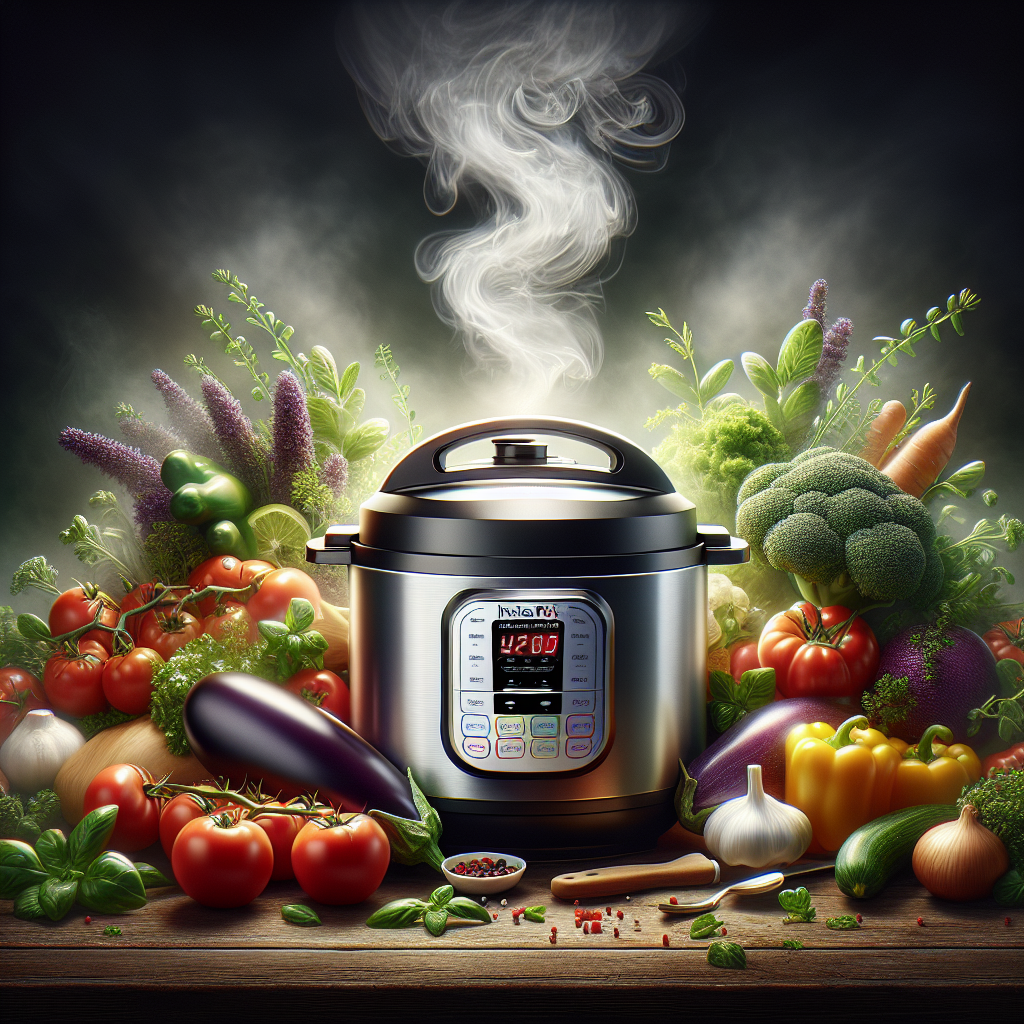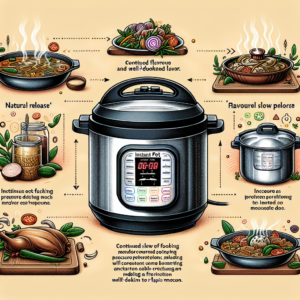In this article, we will guide you through the easy and efficient ways to use an Instant Pot for all your cooking needs. Whether you’re a seasoned chef or a novice in the kitchen, we’ve got you covered with step-by-step instructions on harnessing the power of this versatile appliance. From pressure cooking to sautéing, steaming to slow cooking, we’ll walk you through the various functions and settings of an Instant Pot, ensuring that you can whip up delicious meals in no time. Get ready to revolutionize your cooking experience with our handy tips and tricks for making the most out of your Instant Pot.
Choosing the Right Instant Pot
Determining the size and capacity
When it comes to choosing the right Instant Pot, one of the first things to consider is the size and capacity. Instant Pots come in various sizes, ranging from 3-quart to 8-quart options. The size you choose should depend on your cooking needs and the number of people you typically cook for. If you often cook for a large family or enjoy hosting dinner parties, a larger capacity Instant Pot would be a better fit. On the other hand, if you are only cooking for yourself or a small household, a smaller size may be more practical.
Understanding the different models
Instant Pots are available in different models, each with its own unique features and functions. The most popular models include the Instant Pot Duo, Instant Pot Lux, Instant Pot Ultra, and Instant Pot Max. The Duo is a versatile and budget-friendly option, while the Lux offers a simpler design with fewer features. The Ultra and Max models offer more advanced functionalities, such as altitude adjustment and canning capabilities. Consider your cooking style and the features you desire when choosing the right model for your needs.
Considering the features and functions
While all Instant Pot models serve as multi-cookers, they also come with additional features and functions. Some common features to consider include programmable timers, preset cooking programs, and pressure release methods. Programmable timers allow you to delay the start of your cooking, perfect for those times when you want to come back to a hot, freshly cooked meal. Preset cooking programs are convenient for specific dishes like rice, soup, or yogurt. Pressure release methods, such as quick-release and natural-release, give you control over the cooking process. Consider which features will enhance your cooking experience and make your life easier in the kitchen.
Unboxing and First Steps
Inspecting the package
When you first receive your Instant Pot, take the time to inspect the package and ensure everything is in good condition. Check for any signs of damage or missing parts. It’s essential to have all the necessary components for proper use. This includes the Instant Pot unit, inner pot, sealing ring, steam rack, and condensation collector. If anything is missing or damaged, contact the manufacturer for assistance.
Reading the user manual
Before diving into using your Instant Pot, take some time to read the user manual thoroughly. The manual contains important safety information and instructions on how to operate the appliance correctly. Familiarize yourself with the different parts and their functions, as well as any specific guidelines for your specific model. The user manual will provide you with a solid foundation of knowledge to ensure safe and efficient use of your Instant Pot.
Understanding the parts and accessories
To get the most out of your Instant Pot, it’s crucial to understand its various parts and accessories. The inner pot is where your food will cook, while the sealing ring helps create a secure seal for pressure cooking. The steam rack is useful for cooking items like vegetables or eggs above the liquid level. The condensation collector collects any excess liquid that may drip down during cooking. Familiarize yourself with each component, how they fit together, and their specific functions. This will help you assemble and use your Instant Pot correctly.

Preparing the Instant Pot
Cleaning the Instant Pot
Before using your Instant Pot for the first time, it’s essential to give it a thorough cleaning. Start by washing the inner pot, sealing ring, steam rack, and condensation collector in warm, soapy water. Rinse them thoroughly and ensure they are completely dry before placing them back into the Instant Pot. Wipe down the exterior of the Instant Pot with a damp cloth. This initial cleaning removes any manufacturing residues and ensures your food stays clean and safe during the cooking process.
Checking the sealing ring
The sealing ring is a crucial component that helps maintain pressure during cooking. Before each use, it’s important to inspect the sealing ring to ensure it is in good condition. Look for any signs of damage or wear. If the sealing ring is cracked, torn, or misshapen, it may need to be replaced. Additionally, always check that the sealing ring is properly seated in the lid before cooking. A secure and intact sealing ring is essential for safe and effective pressure cooking.
Assembling the parts correctly
Properly assembling the Instant Pot is essential for safe and efficient cooking. Start by placing the inner pot into the Instant Pot base. Ensure it is properly aligned and securely in place. Next, insert the steam rack into the inner pot, making sure it sits evenly. Attach the condensation collector to the back of the Instant Pot, ensuring it is properly seated. Finally, place the sealing ring onto the lid, making sure it is firmly in place. Double-check that all parts are correctly assembled and secure before beginning your cooking adventures.
Understanding the Control Panel
Getting familiar with the buttons
The control panel is where you will navigate and set your Instant Pot’s cooking settings. Familiarize yourself with the different buttons and their functions. Common buttons include “Pressure Cook/Manual,” “Saute,” “Slow Cook,” “Keep Warm,” and “Cancel.” These buttons allow you to select your desired cooking mode, adjust cooking time and temperature, and cancel or pause the cooking process if necessary. Take the time to read the labels and understand the purpose of each button on your specific Instant Pot model.
Understanding the display screen
The display screen on your Instant Pot provides important information about the cooking process. It usually shows the current cooking mode, cooking time, and pressure level. Some models may also display additional details like preheating status or error codes. Understanding what the display screen is showing will help you monitor your cooking and make any necessary adjustments. If your Instant Pot has a programmable timer feature, the display screen is where you will set the delay start time.
Using the cooking programs
Instant Pots often come with preset cooking programs designed to simplify the cooking process. These programs are tailored for specific dishes or cooking methods, such as rice, soup, chili, or yogurt. Using the cooking programs takes the guesswork out of cooking times and temperature settings. Simply select the appropriate program, and the Instant Pot will adjust the settings automatically. However, it’s important to note that these programs may not be suitable for every recipe. They serve as a helpful starting point, but you may need to make manual adjustments for certain recipes or preferences.

Adding Ingredients and Liquid
Choosing the right ingredients
When using an Instant Pot, it’s important to choose ingredients that are suitable for pressure cooking. While many recipes can be adapted for the Instant Pot, it’s essential to ensure the ingredients can withstand the high heat and pressure. Ingredients like meats, beans, grains, and root vegetables are perfect for pressure cooking. Delicate foods like seafood or leafy greens may not be suitable for long pressure cooking times. Additionally, ensure you have all the necessary ingredients ready and prepped before starting your Instant Pot.
Calculating the liquid requirement
Liquid is a crucial component in pressure cooking as it creates the necessary steam to build pressure. It’s important to follow the recommended liquid requirements for your recipes. As a general rule, you should always have at least 1-2 cups of liquid in the Instant Pot when pressure cooking. This liquid can be water, broth, or any other cooking liquid specified in your recipe. However, be cautious not to exceed the maximum fill line of your Instant Pot to prevent liquid overflow during the cooking process.
Preventing liquid overflow
To prevent liquid overflow during pressure cooking, it’s essential to follow a few guidelines. First, never fill the Instant Pot beyond its maximum fill line. Overfilling can lead to clogging of the steam release valve and potential safety hazards. Additionally, ingredients that expand during cooking, like rice or beans, should be accounted for in your measurements. Leave some space at the top of the Instant Pot to accommodate the expansion. Finally, if your recipe includes ingredients that release a lot of liquid, like tomatoes, adjust the overall liquid quantity accordingly.
Sealing and Venting
Ensuring proper sealing
Proper sealing is crucial for successful pressure cooking. Once you have added your ingredients and liquid, ensure the sealing ring is properly seated in the lid. The sealing ring should fit snugly and be free from damage or wear. Next, align the lid with the Instant Pot base and turn it clockwise until it locks into place. The float valve on the lid should be in the sealed position, indicating that the Instant Pot is properly sealed. Always double-check the seal before starting the cooking process to prevent any issues during cooking.
Using the steam release valve
The steam release valve on your Instant Pot allows you to control the pressure and release steam during cooking. There are two primary methods of releasing steam: quick-release and natural-release. Quick-release means manually venting the steam by turning the steam release valve to the venting position after the cooking cycle is complete. Natural-release involves allowing the pressure to decrease naturally over a specified period of time. It’s important to follow the recipe instructions regarding the appropriate steam release method to ensure the best results.
Understanding the quick-release and natural-release methods
The quick-release method is ideal when you need to stop the cooking process immediately or when the recipe calls for a quick release of pressure. It’s important to exercise caution when using the quick-release method, especially when working with hot liquid or foods. Always use an oven mitt or a long utensil to turn the steam release valve, directing the steam away from yourself and others. Natural-release, on the other hand, allows the pressure to release gradually. This method is often used for delicate foods or recipes that require additional cooking time before releasing the pressure naturally.

Setting the Time and Cooking
Using the manual cooking mode
The manual cooking mode, also known as the pressure cook mode, allows you to manually set the cooking time and pressure level. It gives you full control over the cooking process, making it highly versatile for a wide range of recipes. To use the manual mode, press the “Pressure Cook/Manual” button on your Instant Pot. Use the “+” and “-” buttons to adjust the cooking time. Once you have set the desired time, the Instant Pot will begin heating up and building pressure according to your settings.
Adjusting the cooking time
The cooking time for your recipes may vary depending on the ingredients, quantities, and desired doneness. Adjusting the cooking time is as simple as pressing the “+” or “-” buttons on the control panel. Keep in mind that increasing or decreasing the cooking time can impact the end result of your dish. It’s always a good idea to start with the recommended cooking time in the recipe and make adjustments based on your preferences and experience. Remember that the cooking time does not include the time it takes for the Instant Pot to come to pressure, so factor in additional time for preheating.
Understanding the preheating and cooldown processes
The Instant Pot requires some time to preheat before it starts the actual cooking process. This preheating time allows the Instant Pot to reach the desired cooking temperature and build up pressure. The preheating time varies depending on the recipe and the amount of food being cooked. It’s important to factor in this additional time when planning your meals. Once the cooking time is complete, the Instant Pot will enter the cooldown or keep-warm mode. During this time, the pressure will gradually release, and the temperature will decrease. This cooldown period can vary in length, depending on the recipe and your chosen steam release method.
Understanding the Safety Features
Identifying the safety mechanisms
Instant Pots are designed with multiple safety features to ensure safe and worry-free cooking. Some common safety mechanisms include the lid locking when there is pressure inside the Instant Pot, a pressure release valve to control the pressure build-up, and temperature sensors to prevent overheating. The float valve on the lid acts as an indicator, showing if there is pressure inside the Instant Pot or when it is safe to open. Familiarize yourself with these safety features to ensure you are using your Instant Pot correctly and safely.
Preventing common safety issues
While Instant Pots are generally safe to use, it’s important to be aware of and prevent common safety issues. Always ensure the sealing ring is properly seated and free from damage before starting the cooking process. Avoid overfilling the Instant Pot to prevent liquid overflow and clogging of the steam release valve. Never force open the lid if there is still pressure inside the Instant Pot. Allow the pressure to naturally release or use the quick-release method following the recipe instructions. By following these safety guidelines, you can enjoy safe and worry-free cooking with your Instant Pot.
Handling the steam release safely
The steam release is an essential step in pressure cooking, but it’s important to handle it safely. When performing a quick release, be cautious of the hot steam that will be released from the valve. Always use an oven mitt or a long utensil to turn the valve, ensuring your hand is away from the venting steam. Position the Instant Pot in a well-ventilated area, away from cabinets or walls. Avoid placing your face or body directly above the steam release valve to prevent any potential injuries from the intense heat and pressure. Remember to stay alert and exercise caution when dealing with the steam release process.

Cleaning and Maintenance
Cleaning the removable parts
Regular cleaning and maintenance of your Instant Pot are essential for its longevity and optimal performance. The removable parts, including the inner pot, steam rack, sealing ring, and condensation collector, should be washed after each use. Simply wash them in warm, soapy water, rinse thoroughly, and let them air dry. It’s important to ensure these parts are completely dry before storing them back in the Instant Pot. Additionally, wipe down the exterior of the Instant Pot with a damp cloth to remove any food residue or stains. Taking the time to clean the removable parts will keep your Instant Pot in top condition and prevent any lingering odors.
Removing stinky odors
If your Instant Pot has developed odors from cooking certain foods, there are a few simple methods to remove them. One effective method is to create a mixture of white vinegar and water and fill the inner pot with this solution. Set the Instant Pot to steam for a few minutes, allowing the vinegar steam to penetrate and remove the odors. Another option is to steam a lemon cut into quarters for a refreshing citrus scent. Additionally, you can wash the sealing ring with a baking soda paste to eliminate any odors it may have absorbed. These methods will help keep your Instant Pot smelling fresh and clean.
Taking care of the sealing ring
The sealing ring is an important component of your Instant Pot that can deteriorate over time. To maintain its performance and prolong its lifespan, it’s important to take proper care of the sealing ring. Regularly inspect the sealing ring for any signs of damage, such as cracks or tears. If you notice any issues, consider replacing the sealing ring with a new one. Additionally, after each use, remove the sealing ring from the lid and wash it with warm, soapy water. Allow it to dry completely before placing it back in the Instant Pot. Proper care and maintenance of the sealing ring will ensure a secure and effective seal during pressure cooking.
Troubleshooting Common Issues
Dealing with error codes
Instant Pots are equipped with built-in safety features that may trigger error codes in certain situations. If you encounter an error code on your Instant Pot’s display screen, refer to the user manual for the specific error code and troubleshooting steps. Common error codes may indicate issues like overheating, lack of liquid, or improper sealing. By understanding and addressing these error codes, you can quickly diagnose and resolve any problems with your Instant Pot.
Fixing leaking problems
Leaking is a common issue that can occur with an Instant Pot. If you notice liquid or steam escaping from the lid or other areas of the Instant Pot during cooking, there are a few steps you can take to address the problem. First, ensure the sealing ring is properly seated and free from any damage. Check that the lid is securely locked in place and that the float valve is properly aligned. Additionally, make sure you are not overfilling the Instant Pot beyond the maximum fill line. If the issue persists, consider reaching out to the Instant Pot manufacturer for further assistance and troubleshooting.
Addressing cooking inconsistencies
If you find that your food is not cooking consistently or to your desired doneness, there are a few factors to consider. First, ensure the sealing ring is properly seated and the Instant Pot is fully sealed. A secure seal is crucial for maintaining pressure and even cooking. Check the cooking time and make sure it is appropriate for the specific recipe and ingredients. Additionally, adjust the cooking time if needed to achieve the desired results. You can also experiment with different cooking methods, such as natural-release versus quick-release, to find the method that works best for your recipes. With a bit of troubleshooting and experimentation, you can overcome any cooking inconsistencies and enjoy delicious meals with your Instant Pot.





